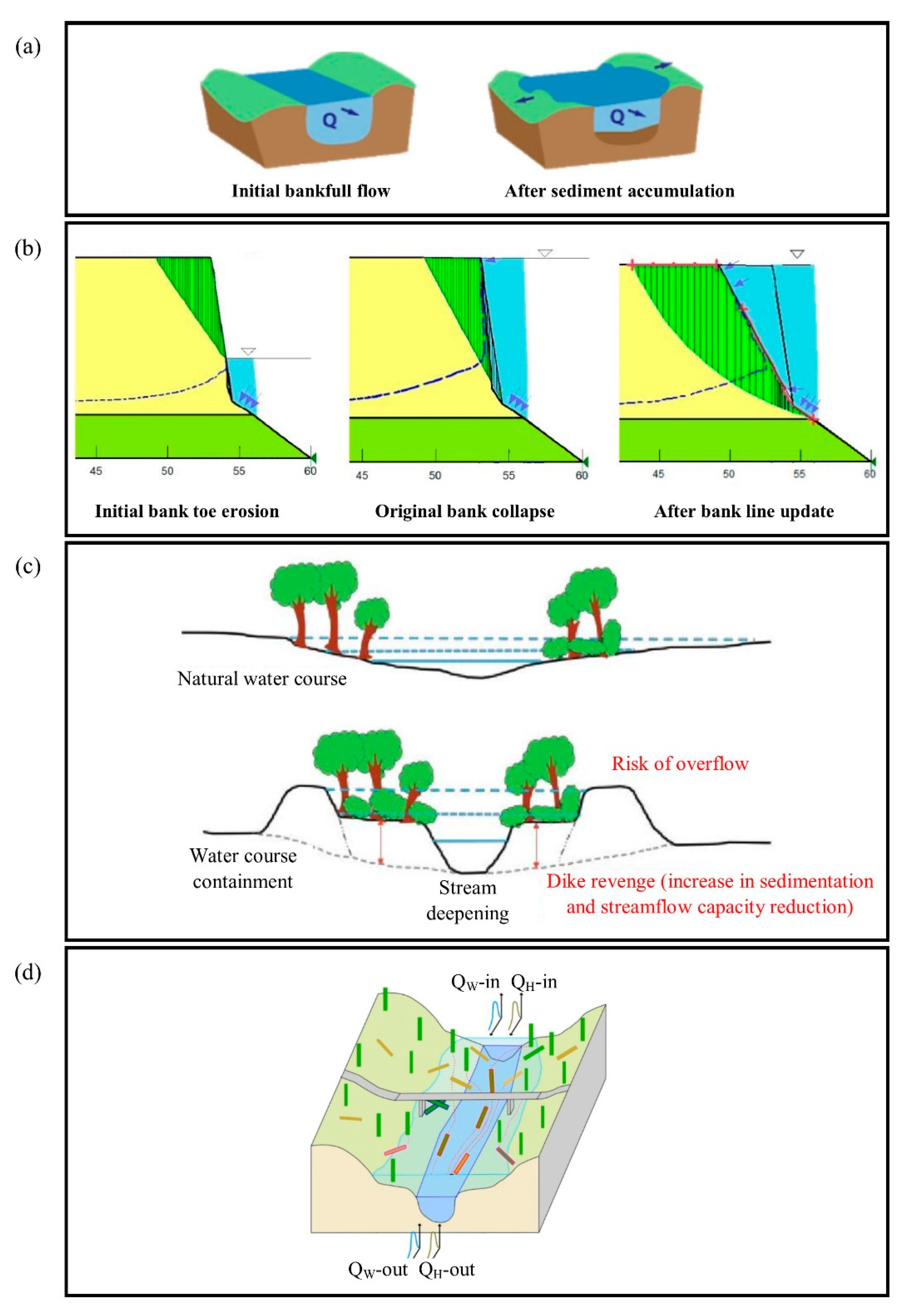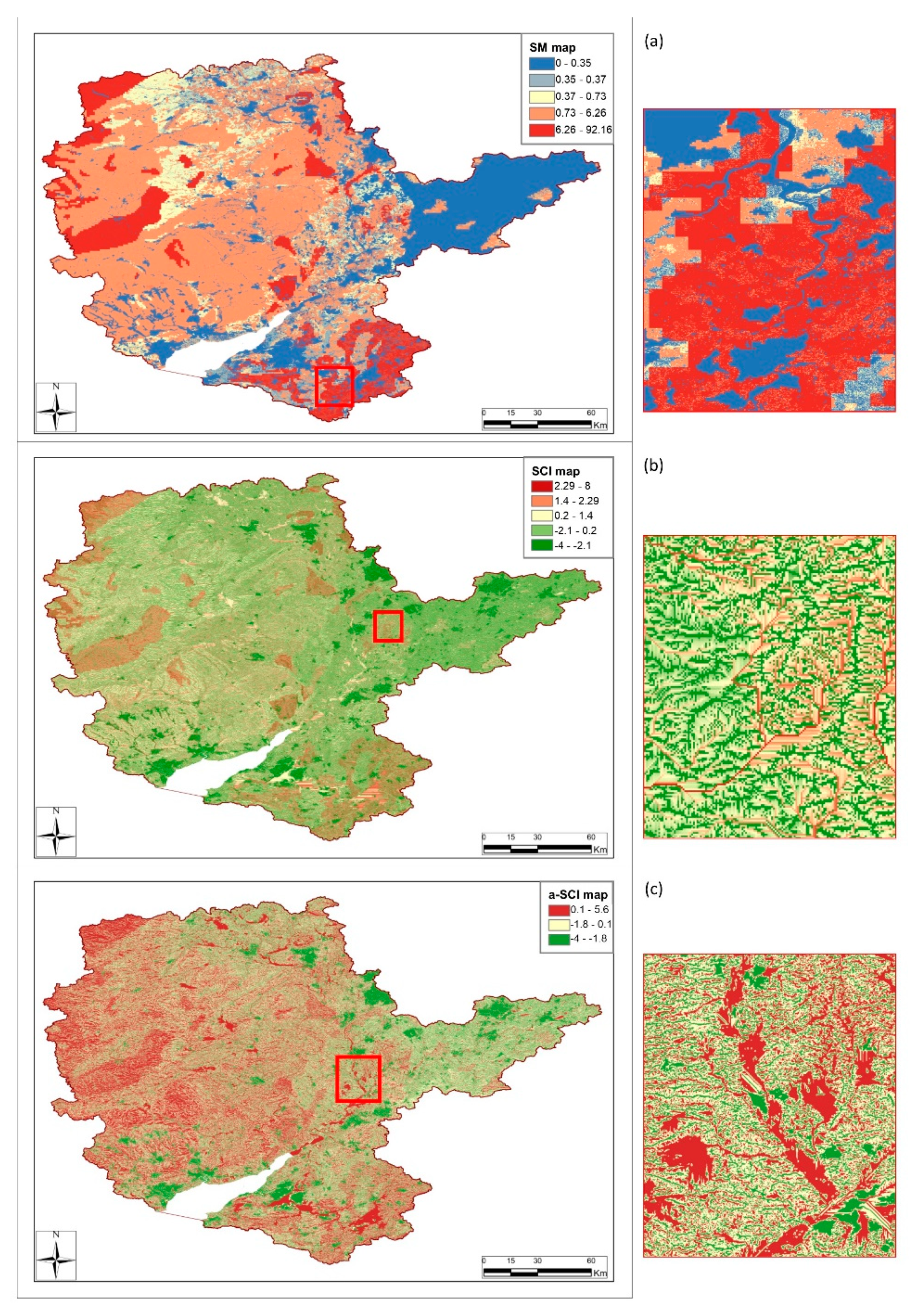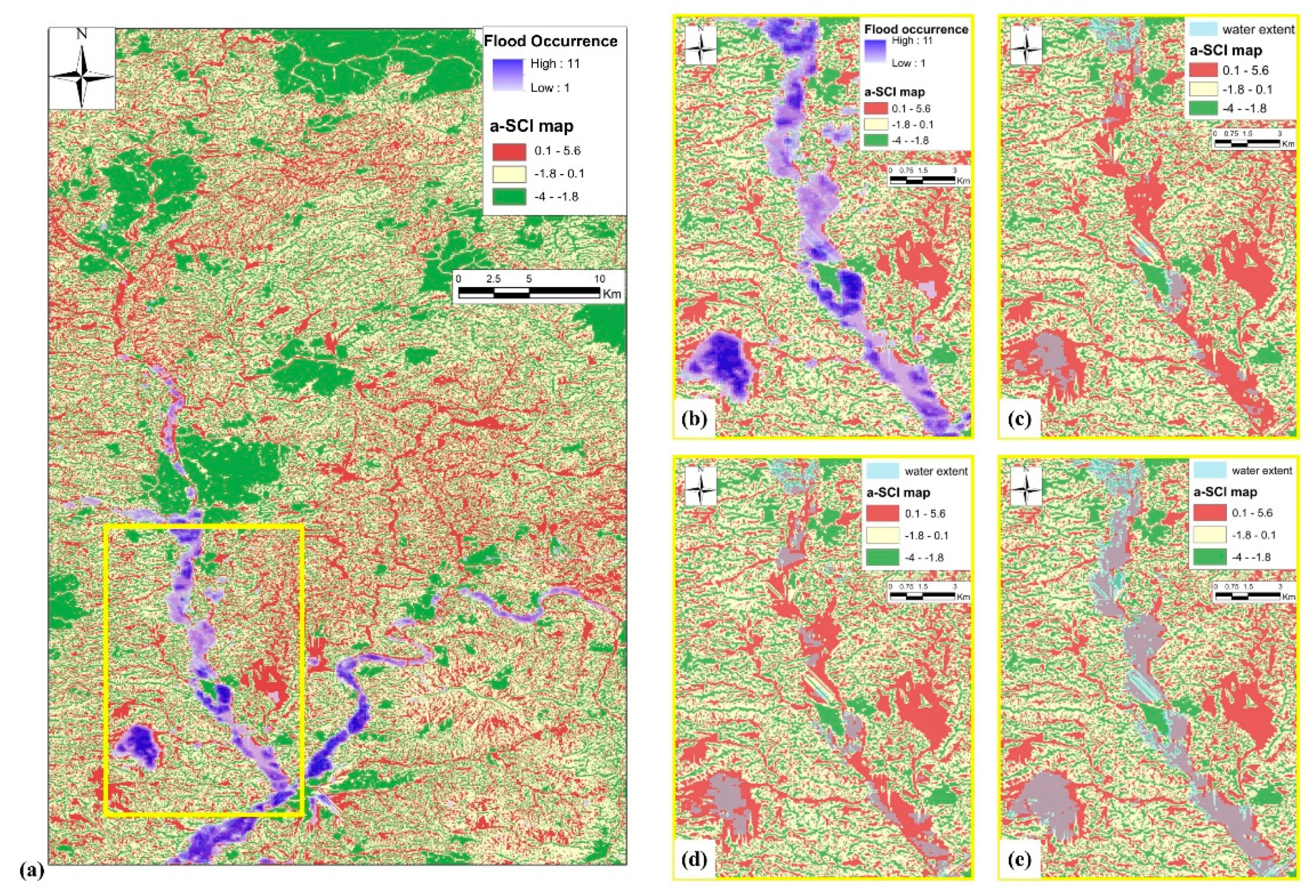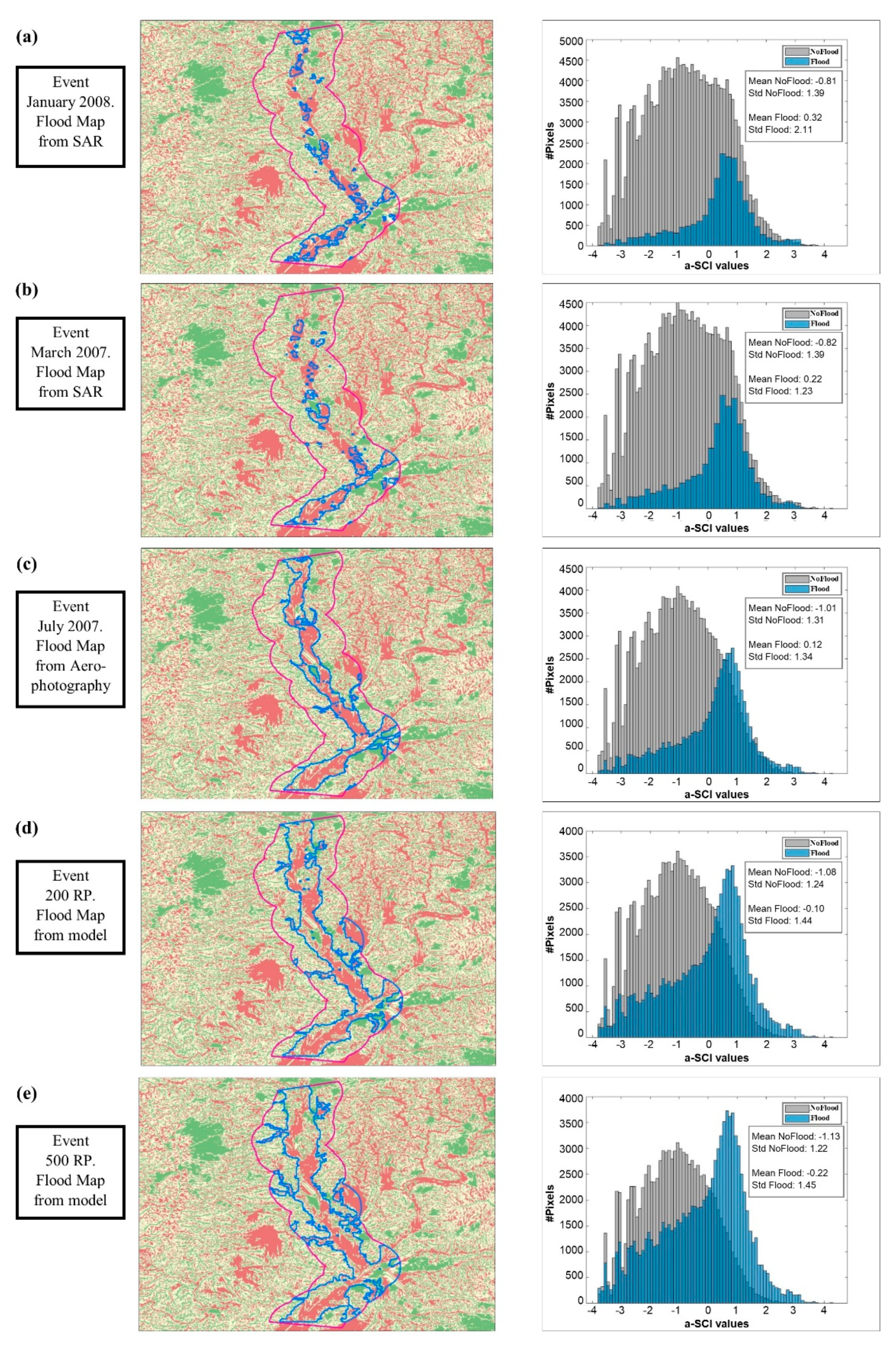Experimental Application of Sediment Flow Connectivity Index (SCI) in Flood Monitoring
Abstract
1. Introduction
2. Study Area
3. Data and Methods
3.1. SCI Map Computation
3.2. SCI Map Data
3.3. Flood Maps
3.4. SCI and Flood Maps Comparison
4. Results
4.1. SM, SCI and a-SCI Maps
4.2. SCI Comparison with Flood Occurrence
5. Discussion
6. Conclusions
Author Contributions
Funding
Acknowledgments
Conflicts of Interest
References
- Caine, N.; Swanson, F.J. Geomorphic Coupling of Hillslope and Channel Systems in Two Small Mountain Basins. Z. Geo-Morphol. 1989, 33, 189–203. [Google Scholar]
- Hooke, J. Coarse Sediment Connectivity in River Channel Systems: A Conceptual Framework and Methodology. Geomorphology 2003, 56, 79–94. [Google Scholar] [CrossRef]
- Wohl, E. Connectivity in Rivers. Prog. Phys. Geogr. Earth Environ. 2017, 41, 345–362. [Google Scholar] [CrossRef]
- Heckmann, T.; Cavalli, M.; Cerdan, O.; Foerster, S.; Javaux, M.; Lode, E.; Smetanová, A.; Vericat, D.; Brardinoni, F. Indices of Sediment Connectivity: Opportunities, Challenges and Limitations. Earth-Sci. Rev. 2018, 187, 77–108. [Google Scholar] [CrossRef]
- Turnbull, L.; Wainwright, J.; Brazier, R.E. A Conceptual Framework for Understanding Semi-Arid Land Degradation: Ecohydrological Interactions across Multiple-Space and Time Scales. Ecohydrology 2008, 1, 23–34. [Google Scholar] [CrossRef]
- Wainwright, J.; Turnbull, L.; Ibrahim, T.G.; Lexartza-Artza, I.; Thornton, S.F.; Brazier, R.E. Linking Environmental Régimes, Space and Time: Interpretations of Structural and Functional Connectivity. Geomorphology 2011, 126, 387–404. [Google Scholar] [CrossRef]
- Bracken, L.J.; Turnbull, L.; Wainwright, J.; Bogaart, P. Sediment Connectivity: A Framework for Understanding Sediment Transfer at Multiple Scales. Earth Surf. Process. Landf. 2015, 40, 177–188. [Google Scholar] [CrossRef]
- Vergari, F.; Della Seta, M.; Del Monte, M.; Barbieri, M. Badlands Denudation “Hot Spots”: The Role of Parent Material Properties on Geomorphic Processes in 20-Years Monitored Sites of Southern Tuscany (Italy). CATENA 2013, 106, 31–41. [Google Scholar] [CrossRef]
- Wohl, E.E. Rivers in the Landscape: Science and Managment; John Wiley & Sons Inc.: Hoboken, NJ, USA, 2014. [Google Scholar]
- Brierley, G.; Fryirs, K.; Jain, V. Landscape Connectivity: The Geographic Basis of Geomorphic Applications. Area 2006, 38, 165–174. [Google Scholar] [CrossRef]
- Doyle, M.W.; Ensign, S.H. Alternative Reference Frames in River System Science. BioScience 2009, 59, 499–510. [Google Scholar] [CrossRef][Green Version]
- Faulkner, H. Connectivity as a Crucial Determinant of Badland Morphology and Evolution. Geomorphology 2008, 100, 91–103. [Google Scholar] [CrossRef]
- Fryirs, K. (Dis)Connectivity in Catchment Sediment Cascades: A Fresh Look at the Sediment Delivery Problem. Earth Surf. Process. Landf. 2013, 38, 30–46. [Google Scholar] [CrossRef]
- Heckmann, T.; Schwanghart, W. Geomorphic Coupling and Sediment Connectivity in an Alpine Catchment—Exploring Sediment Cascades Using Graph Theory. Geomorphology 2013, 182, 89–103. [Google Scholar] [CrossRef]
- Poeppl, R.E.; Parsons, A.J. The Geomorphic Cell: A Basis for Studying Connectivity. Earth Surf. Process. Landf. 2018, 43, 1155–1159. [Google Scholar] [CrossRef]
- Borselli, L.; Cassi, P.; Torri, D. Prolegomena to Sediment and Flow Connectivity in the Landscape: A GIS and Field Numerical Assessment. CATENA 2008, 75, 268–277. [Google Scholar] [CrossRef]
- Cavalli, M.; Trevisani, S.; Comiti, F.; Marchi, L. Geomorphometric Assessment of Spatial Sediment Connectivity in Small Alpine Catchments. Geomorphology 2013, 188, 31–41. [Google Scholar] [CrossRef]
- Chartin, C.; Evrard, O.; Laceby, J.P.; Onda, Y.; Ottlé, C.; Lefèvre, I.; Cerdan, O. The Impact of Typhoons on Sediment Connectivity: Lessons Learnt from Contaminated Coastal Catchments of the Fukushima Prefecture (Japan): Typhoon Impact on Sediment Connectivity–Fukushima, Japan. Earth Surf. Process. Landf. 2017, 42, 306–317. [Google Scholar] [CrossRef]
- Ali, G.; Oswald, C.; Spence, C.; Wellen, C. The T-TEL Method for Assessing Water, Sediment, and Chemical Connectivity. Water Resour. Res. 2018, 54, 634–662. [Google Scholar] [CrossRef]
- Baartman, J.E.M.; Masselink, R.; Keesstra, S.D.; Temme, A.J.A.M. Linking Landscape Morphological Complexity and Sediment Connectivity. Earth Surf. Process. Landf. 2013, 38, 1457–1471. [Google Scholar] [CrossRef]
- Coulthard, T.J.; Van De Wiel, M.J. Modelling Long Term Basin Scale Sediment Connectivity, Driven by Spatial Land Use Changes. Geomorphology 2017, 277, 265–281. [Google Scholar] [CrossRef]
- Kondolf, G.M.; Boulton, A.J.; O’Daniel, S.; Poole, G.C.; Rahel, F.J.; Stanley, E.H.; Wohl, E.; Bång, A.; Carlstrom, J.; Cristoni, C.; et al. Process-Based Ecological River Restoration: Visualizing Three-Dimensional Connectivity and Dynamic Vectors to Recover Lost Linkages. Ecol. Soc. 2006, 11, 13–37. [Google Scholar] [CrossRef]
- Poeppl, R.E.; Keesstra, S.D.; Maroulis, J. A Conceptual Connectivity Framework for Understanding Geomorphic Change in Human-Impacted Fluvial Systems. Geomorphology 2017, 277, 237–250. [Google Scholar] [CrossRef]
- Cavalli, M.; Vericat, D.; Pereira, P. Mapping Water and Sediment Connectivity. Sci. Total Environ. 2019, 673, 763–767. [Google Scholar] [CrossRef] [PubMed]
- Grauso, S.; Pasanisi, F.; Tebano, C. Assessment of a Simplified Connectivity Index and Specific Sediment Potential in River Basins by Means of Geomorphometric Tools. Geosciences 2018, 8, 48. [Google Scholar] [CrossRef]
- Ludwig, J.A.; Bastin, G.N.; Chewings, V.H.; Eager, R.W.; Liedloff, A.C. Leakiness: A New Index for Monitoring the Health of Arid and Semiarid Landscapes Using Remotely Sensed Vegetation Cover and Elevation Data. Ecol. Indic. 2007, 7, 442–454. [Google Scholar] [CrossRef]
- Capolongo, D.; Refice, A.; Bocchiola, D.; D’Addabbo, A.; Vouvalidis, K.; Soncini, A.; Zingaro, M.; Bovenga, F.; Stamatopoulos, L. Coupling Multitemporal Remote Sensing with Geomorphology and Hydrological Modeling for Post Flood Recovery in the Strymonas Dammed River Basin (Greece). Sci. Total Environ. 2019, 651, 1958–1968. [Google Scholar] [CrossRef] [PubMed]
- Cantreul, V.; Bielders, C.; Calsamiglia, A.; Degré, A. How Pixel Size Affects a Sediment Connectivity Index in Central Belgium. Earth Surf. Process. Landf. 2018, 43, 884–893. [Google Scholar] [CrossRef]
- Fuller, I.C.; Large, A.R.G.; Charlton, M.E.; Heritage, G.L.; Milan, D.J. Reach-Scale Sediment Transfers: An Evaluation of Two Morphological Budgeting Approaches. Earth Surf. Process. Landf. 2003, 28, 889–903. [Google Scholar] [CrossRef]
- Poole, G.C.; Stanford, J.A.; Running, S.W.; Frissell, C.A. Multiscale Geomorphic Drivers of Groundwater Flow Paths: Subsurface Hydrologic Dynamics and Hyporheic Habitat Diversity. J. N. Am. Benthol. Soc. 2006, 25, 288–303. [Google Scholar] [CrossRef]
- Sidle, R.C.; Gomi, T.; Loaiza Usuga, J.C.; Jarihani, B. Hydrogeomorphic Processes and Scaling Issues in the Continuum from Soil Pedons to Catchments. Earth-Sci. Rev. 2017, 175, 75–96. [Google Scholar] [CrossRef]
- Cavalli, M.; Tarolli, P.; Dalla Fontana, G.; Marchi, L. Multi-Temporal Analysis of Sediment Source Areas and Sediment Connectivity in the Rio Cordon Catchment (Dolomites). Rendiconti Online Della Soc. Geol. Ital. 2016, 39, 27–30. [Google Scholar] [CrossRef]
- de Musso, N.M.; Capolongo, D.; Caldara, M.; Surian, N.; Pennetta, L. Channel Changes and Controlling Factors over the Past 150 Years in the Basento River (Southern Italy). Water 2020, 12, 307. [Google Scholar] [CrossRef]
- Kalantari, Z.; Cavalli, M.; Cantone, C.; Crema, S.; Destouni, G. Flood Probability Quantification for Road Infrastructure: Data-Driven Spatial-Statistical Approach and Case Study Applications. Sci. Total Environ. 2017, 581–582, 386–398. [Google Scholar] [CrossRef] [PubMed]
- Kuo, C.-W.; Brierley, G. The Influence of Landscape Connectivity and Landslide Dynamics upon Channel Adjustments and Sediment Flux in the Liwu Basin, Taiwan. Earth Surf. Process. Landf. 2014, 39, 2038–2055. [Google Scholar] [CrossRef]
- Lisenby, P.E.; Fryirs, K.A.; Thompson, C.J. River Sensitivity and Sediment Connectivity as Tools for Assessing Future Geomorphic Channel Behavior. Int. J. River Basin Manag. 2019, 1–48. [Google Scholar] [CrossRef]
- Rinaldi, M.; Amponsah, W.; Benvenuti, M.; Borga, M.; Comiti, F.; Lucía, A.; Marchi, L.; Nardi, L.; Righini, M.; Surian, N. An Integrated Approach for Investigating Geomorphic Response to Extreme Events: Methodological Framework and Application to the October 2011 Flood in the Magra River Catchment, Italy. Earth Surf. Process. Landf. 2016, 41, 835–846. [Google Scholar] [CrossRef]
- Surian, N.; Righini, M.; Lucía, A.; Nardi, L.; Amponsah, W.; Benvenuti, M.; Borga, M.; Cavalli, M.; Comiti, F.; Marchi, L.; et al. Channel Response to Extreme Floods: Insights on Controlling Factors from Six Mountain Rivers in Northern Apennines, Italy. Geomorphology 2016, 272, 78–91. [Google Scholar] [CrossRef]
- Arnaud-Fassetta, G.; Astrade, L.; Bardou, É.; Corbonnois, J.; Delahaye, D.; Fort, M.; Gautier, E.; Jacob, N.; Peiry, J.-L.; Piégay, H.; et al. Fluvial geomorphology and flood-risk management. Géomorphologie Relief Process. Environ. 2009, 15, 109–128. [Google Scholar] [CrossRef]
- Zingaro, M.; Refice, A.; Giachetta, E.; D’Addabbo, A.; Lovergine, F.; De Pasquale, V.; Pepe, G.; Brandolini, P.; Cevasco, A.; Capolongo, D. Sediment Mobility and Connectivity in a Catchment: A New Mapping Approach. Sci. Total Environ. 2019, 672, 763–775. [Google Scholar] [CrossRef]
- Messenzehl, K.; Hoffmann, T.; Dikau, R. Sediment Connectivity in the High-Alpine Valley of Val Müschauns, Swiss National Park—Linking Geomorphic Field Mapping with Geomorphometric Modelling. Geomorphology 2014, 221, 215–229. [Google Scholar] [CrossRef]
- Schneevoigt, N.J.; van der Linden, S.; Thamm, H.-P.; Schrott, L. Detecting Alpine Landforms from Remotely Sensed Imagery. A Pilot Study in the Bavarian Alps. Geomorphology 2008, 93, 104–119. [Google Scholar] [CrossRef]
- Walling, D.E.; Zhang, Y. Predicting Slope-Channel Connectivity: A National-Scale Approach. In Sediment Transfer through the Fluvial System, Proceedings of a symposium held in Moscow, 2–6 August 2004; Golosov, V., Belyaev, V., Walling, D.E., Eds.; IAHS: Wallingford, UK, 2004; No. 288; pp. 107–114. [Google Scholar]
- Duong Thi, T.; Do Minh, D. Riverbank Stability Assessment under River Water Level Changes and Hydraulic Erosion. Water 2019, 11, 2598. [Google Scholar] [CrossRef]
- Zanetti, C.; Macia, J.; Liency, N.; Vennetier, M.; Mériaux, P.; Provansal, M. Roles of the Riparian Vegetation: The Antagonism between Flooding Risk and the Protection of Environments. E3S Web Conf. 2016, 7, 13015. [Google Scholar] [CrossRef]
- Zischg, A.P.; Galatioto, N.; Deplazes, S.; Weingartner, R.; Mazzorana, B. Modelling Spatiotemporal Dynamics of Large Wood Recruitment, Transport, and Deposition at the River Reach Scale during Extreme Floods. Water 2018, 10, 1134. [Google Scholar] [CrossRef]
- Gregory, K.J.; Thornes, J.B. The Severn Basin: Sample Basin Review [Le Bassin de La Severn]. Quaternaire 1980, 17, 61–64. [Google Scholar] [CrossRef]
- Hillier, R.D.; Williams, B.P.J. The alluvial OLD Red Sandstone: Fluvial Basins. In The Geology of England and Wales; Brenchley, P.J., Rawson, P.F., Eds.; The Geological Society: London, UK, 2006; pp. 155–172. [Google Scholar]
- Maddy, D.; Green, C.P.; Lewis, S.G.; Bowen, D.Q. Pleistocene Geology of the Lower Severn Valley, U.K. Quat. Sci. Rev. 1995, 14, 209–222. [Google Scholar] [CrossRef]
- Hooke, J.; Sandercock, P.; Cammeraat, L.H.; Lesschen, J.P.; Borselli, L.; Torri, D.; Meerkerk, A.; van Wesemael, B.; Marchamalo, M.; Barbera, G.; et al. Mechanisms of Degradation and Identification of Connectivity and Erosion Hotspots. In Combating Desertification and Land Degradation; Springer: Cham, Switzerland, 2017; pp. 13–37. [Google Scholar] [CrossRef]
- Lizaga, I.; Quijano, L.; Palazón, L.; Gaspar, L.; Navas, A. Enhancing Connectivity Index to Assess the Effects of Land Use Changes in a Mediterranean Catchment. Land Degrad. Dev. 2018, 29, 663–675. [Google Scholar] [CrossRef]
- Wohl, E.; Rathburn, S.; Chignell, S.; Garrett, K.; Laurel, D.; Livers, B.; Patton, A.; Records, R.; Richards, M.; Schook, D.M.; et al. Mapping Longitudinal Stream Connectivity in the North St. Vrain Creek Watershed of Colorado. Geomorphology 2017, 277, 171–181. [Google Scholar] [CrossRef]
- Tanguy, M.; Dixon, H.; Prosdocimi, I.; Morris, D.G.; Keller, V.D.J. Gridded Estimates of Daily and Monthly Areal Rainfall for the United Kingdom (1890–2015) [CEH-GEAR]. Available online: https://doi.org/10.5285/33604EA0-C238-4488-813D-0AD9AB7C51CA (accessed on 26 June 2020).
- Keller, V.D.J.; Tanguy, M.; Prosdocimi, I.; Terry, J.A.; Hitt, O.; Cole, S.J.; Fry, M.; Morris, D.G.; Dixon, H. CEH-GEAR: 1 Km Resolution Daily and Monthly Areal Rainfall Estimates for the UK for Hydrological and Other Applications. Earth Syst. Sci. Data 2015, 7, 143–155. [Google Scholar] [CrossRef]
- Cevasco, A.; Pepe, G.; Brandolini, P. The Influences of Geological and Land Use Settings on Shallow Landslides Triggered by an Intense Rainfall Event in a Coastal Terraced Environment. Bull. Eng. Geol. Environ. 2014, 73, 859–875. [Google Scholar] [CrossRef]
- Wilson, M.F.J.; O’Connell, B.; Brown, C.; Guinan, J.C.; Grehan, A.J. Multiscale Terrain Analysis of Multibeam Bathymetry Data for Habitat Mapping on the Continental Slope. Mar. Geod. 2007, 30, 3–35. [Google Scholar] [CrossRef]
- Chini, M.; Hostache, R.; Giustarini, L.; Matgen, P. A Hierarchical Split-Based Approach for Parametric Thresholding of SAR Images: Flood Inundation as a Test Case. IEEE Trans. Geosci. Remote Sens. 2017, 55, 6975–6988. [Google Scholar] [CrossRef]
- Giustarini, L.; Hostache, R.; Matgen, P.; Schumann, G.J.-P.; Bates, P.D.; Mason, D.C. A Change Detection Approach to Flood Mapping in Urban Areas Using TerraSAR-X. IEEE Trans. Geosci. Remote Sens. 2013, 51, 2417–2430. [Google Scholar] [CrossRef]
- Giustarini, L.; Vernieuwe, H.; Verwaeren, J.; Chini, M.; Hostache, R.; Matgen, P.; Verhoest, N.E.C.; De Baets, B. Accounting for Image Uncertainty in SAR-Based Flood Mapping. Int. J. Appl. Earth Obs. Geoinformation 2015, 34, 70–77. [Google Scholar] [CrossRef]
- Giustarini, L.; Hostache, R.; Kavetski, D.; Chini, M.; Corato, G.; Schlaffer, S.; Matgen, P. Probabilistic Flood Mapping Using Synthetic Aperture Radar Data. IEEE Trans. Geosci. Remote Sens. 2016, 54, 6958–6969. [Google Scholar] [CrossRef]
- Hostache, R.; Matgen, P.; Wagner, W. Change Detection Approaches for Flood Extent Mapping: How to Select the Most Adequate Reference Image from Online Archives? Int. J. Appl. Earth Obs. Geoinformation 2012, 19, 205–213. [Google Scholar] [CrossRef]
- Matgen, P.; Hostache, R.; Schumann, G.; Pfister, L.; Hoffmann, L.; Savenije, H.H.G. Towards an Automated SAR-Based Flood Monitoring System: Lessons Learned from Two Case Studies. Phys. Chem. Earth Parts ABC 2011, 36, 241–252. [Google Scholar] [CrossRef]
- Hostache, R.; Chini, M.; Giustarini, L.; Neal, J.; Kavetski, D.; Wood, M.; Corato, G.; Pelich, R.-M.; Matgen, P. Near-Real-Time Assimilation of SAR-Derived Flood Maps for Improving Flood Forecasts. Water Resour. Res. 2018, 54, 5516–5535. [Google Scholar] [CrossRef]
- Wood, M.; Hostache, R.; Neal, J.; Wagener, T.; Giustarini, L.; Chini, M.; Corato, G.; Matgen, P.; Bates, P. Calibration of Channel Depth and Friction Parameters in the LISFLOOD-FP Hydraulic Model Using Medium-Resolution SAR Data and Identifiability Techniques. Hydrol. Earth Syst. Sci. 2016, 20, 4983–4997. [Google Scholar] [CrossRef]
- Hostache, R.; Hissler, C.; Matgen, P.; Guignard, C.; Bates, P. Modelling Suspended-Sediment Propagation and Related Heavy Metal Contamination in Floodplains: A Parameter Sensitivity Analysis. Hydrol. Earth Syst. Sci. 2014, 18, 3539–3551. [Google Scholar] [CrossRef]
- Lepesqueur, J.; Hostache, R.; Martínez-Carreras, N.; Montargès-Pelletier, E.; Hissler, C. Sediment Transport Modelling in Riverine Environments: On the Importance of Grain-Size Distribution, Sediment Density, and Suspended Sediment Concentrations at the Upstream Boundary. Hydrol. Earth Syst. Sci. 2019, 23, 3901–3915. [Google Scholar] [CrossRef]
- Buraas, E.M.; Renshaw, C.E.; Magilligan, F.J.; Dade, W.B. Impact of Reach Geometry on Stream Channel Sensitivity to Extreme Floods. Earth Surf. Process. Landf. 2014, 39, 1778–1789. [Google Scholar] [CrossRef]
- Comiti, F.; Lucía, A.; Rickenmann, D. Large Wood Recruitment and Transport during Large Floods: A Review. Geomorphology 2016, 269, 23–39. [Google Scholar] [CrossRef]
- Krapesch, G.; Hauer, C.; Habersack, H. Scale Orientated Analysis of River Width Changes Due to Extreme Flood Hazards. Nat. Hazards Earth Syst. Sci. 2011, 11, 2137–2147. [Google Scholar] [CrossRef]
- Sholtes, J.S.; Yochum, S.E.; Scott, J.A.; Bledsoe, B.P. Longitudinal Variability of Geomorphic Response to Floods: Geomorphic Response to Floods. Earth Surf. Process. Landf. 2018, 43, 3099–3113. [Google Scholar] [CrossRef]
- Tamminga, A.D.; Eaton, B.C.; Hugenholtz, C.H. UAS-Based Remote Sensing of Fluvial Change Following an Extreme Flood Event. Earth Surf. Process. Landf. 2015, 40, 1464–1476. [Google Scholar] [CrossRef]







| Rainfall MAP (mm per year) | Rainfall Index Values |
|---|---|
| 667–668 | 0.05 |
| 669–719 | 0.11 |
| 720–772 | 0.18 |
| 773–825 | 0.24 |
| 826–878 | 0.3 |
| 879–931 | 0.36 |
| 932–984 | 0.43 |
| 985–1037 | 0.49 |
| 1038–1089 | 0.55 |
| 1090–1142 | 0.62 |
| 1143–1195 | 0.68 |
| 1196–1247 | 0.81 |
| 1248–1300 | 0.87 |
| 1301–1353 | 0.93 |
| 1354–1406 | 0.99 |
| 1407–1460 | 1 |
| Soil Properties | Soil Properties Classes |
|---|---|
| Permeability classes | |
| Impermeable within 40 cm | LP |
| Permeable between 40 and 150 cm | MP |
| Permeable within 150 cm | HP |
| Bulk density values | |
| <1.4 kg/dm3 | LB |
| ≥1.4 kg/dm3 | HB |
| Thickness classes | |
| ≤1 m | LT |
| 1–3 m | MT |
| ≥3 m | HT |
| Soil Properties Conditions | Soil Stability Index Values |
|---|---|
| LP and HB or LT | 0.05 |
| MP and HB or MT | 0.50 |
| HP and LB or HT | 1 |
| Land Cover Classes | Land Cover Index Values |
|---|---|
| Urban areas | 0 |
| Grassland, pastures, shrubs, moorland | 0.25 |
| Woods, forests | 0.50 |
| Arable fields, croplands | 0.75 |
| Bare soils, wetlands | 1 |
© 2020 by the authors. Licensee MDPI, Basel, Switzerland. This article is an open access article distributed under the terms and conditions of the Creative Commons Attribution (CC BY) license (http://creativecommons.org/licenses/by/4.0/).
Share and Cite
Zingaro, M.; Refice, A.; D’Addabbo, A.; Hostache, R.; Chini, M.; Capolongo, D. Experimental Application of Sediment Flow Connectivity Index (SCI) in Flood Monitoring. Water 2020, 12, 1857. https://doi.org/10.3390/w12071857
Zingaro M, Refice A, D’Addabbo A, Hostache R, Chini M, Capolongo D. Experimental Application of Sediment Flow Connectivity Index (SCI) in Flood Monitoring. Water. 2020; 12(7):1857. https://doi.org/10.3390/w12071857
Chicago/Turabian StyleZingaro, Marina, Alberto Refice, Annarita D’Addabbo, Renaud Hostache, Marco Chini, and Domenico Capolongo. 2020. "Experimental Application of Sediment Flow Connectivity Index (SCI) in Flood Monitoring" Water 12, no. 7: 1857. https://doi.org/10.3390/w12071857
APA StyleZingaro, M., Refice, A., D’Addabbo, A., Hostache, R., Chini, M., & Capolongo, D. (2020). Experimental Application of Sediment Flow Connectivity Index (SCI) in Flood Monitoring. Water, 12(7), 1857. https://doi.org/10.3390/w12071857









